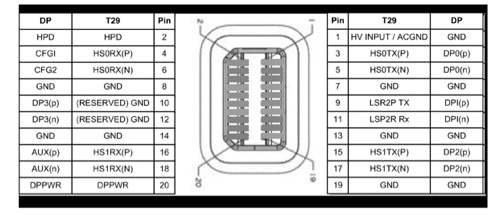Three Apple patents involving cables — and apparently Thunderbolt technology — have appeared at the U.S. Patent & Trademark Office.
Thunderbolt is an interface for connecting peripheral devices to a computer via an expansion bus. Thunderbolt was developed by Intel and brought to market with technical collaboration from Apple.
Patent number 20120005496 involves power distribution inside a cable. The invention — shown in the first graphic — involves circuits, methods, and apparatus that provide for the powering of active components in connector inserts at each end of a cable may in various ways. For example, where a host is coupled to a device that is not self-powered, the host may provide power for circuitry at each end of the cable.
In various embodiments of the present invention, the device may request higher voltage from the host, such that more power can be delivered. In these cases, the device may regulate the voltage received from the host to a lower voltage, and then provide the lower voltage to circuitry at one or both ends of the cable. Where the host is connected to a device that is self-powered, the host and the self-powered device may power their respective connector insert circuits. The inventors are Paul A. Baker, William O. Ferry and James Orr.
Patent number 2012000705 is for circuitry for an active cable. Circuits, methods, and apparatus that allow signals that are compliant with multiple standards to share a common connector on an electronic device are provided. An exemplary embodiment of the present invention — shown in the second graphic — provides a connector that provides signals compatible with a legacy standard in one mode and a newer standard in another mode.
Apple says “what is needed are circuits, methods, and apparatus that allow various standards to share a common connector.”The inventors are William P. Cornelius, William O. Ferry and James E. Orr.
Patent number 2012000703 involves high-speed connector inserts and cables. Per the patent — shown in the third graphic — high speed connector inserts and cables having improved heat conduction, high strength, and may be manufactured in a reliable manner. One example may provide a connector insert having several paths by which heat may be removed from circuitry in the cable insert. In one example, heat may be removed from one or more circuits by forming a thermal path between a circuit and a shield of the connector insert.
Another path may include one or more pads on a side of an integrated circuit board that are soldered directly to the shield. A braiding surrounding a cable may be soldered or otherwise thermally connected to the shield. Another example may provide a cable having a braiding that includes one or more types of fibers, such as aramid fibers. Another example may provide for increased manufacturability by using a wire comb and a solder bar.
Apple says what is needed are circuits, methods, and apparatus for high-speed cables that can reliably convey signals in high-speed communications. The cable inserts may be able to transfer heat in a way to improve user experience and cable reliability. The cables may have increased strength. The cables and connector inserts may be arranged in such a way as to provide improved manufacturability. The inventors are Min Chul Kim, Paul Yuan, Josh Pong and Joseph Tang.
Also appearing at the U.S. Patent & Trademark Office today is a patent (number 20120001933) for computations of power functions using polynomial approximations. Per the patent a power function is approximated over an applicable data interval with polynomials determined by means of a Chebyshev minimax approximation technique. In some cases, multiple polynomials may be used to approximate the function over respective ranges of the desirable interval, in a piecewise manner.
The appropriate polynomial that approximates the power function over the range of interest is derived and stored. When the power function is to be applied to a particular data value, the data value is first evaluated to determine where it lies within the applicable interval. The constants for the polynomial associated with that range of the interval are then retrieved and used to calculate the power of that data value. Ali Sazegari and Ian Ollmann are the inventors.



